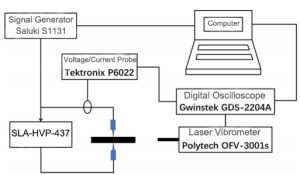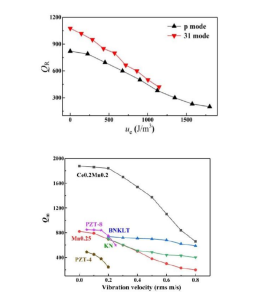Research direction: To test the high-power mechanical quality factor at high vibration speed, and to objectively reflect the performance of the piezoelectric element when it is applied.
Test equipment: signal generator, voltage/current probe, computer, SLA-HVP-437 High Voltage Power Amplifier, digital oscilloscope, laser vibrometer, fixture and piezoelectric ceramic samples, etc.
Experiment procedure:
The test system mainly includes signal generator, high-voltage amplifier, digital oscilloscope, voltage/current probe, laser Doppler velocimeter, computer control system and software, etc. During the test, the computer control software issues instructions, and the signal generator triggers an initial sinusoidal signal after receiving the instructions, which is amplified by a high-voltage amplifier and applied to the sample to be tested, causing the sample to vibrate. During the vibration of the sample, the laser Doppler vibration velocimeter monitors its vibration speed, and the probe collects the voltage across the sample or the current passing through the sample. The test results of the two are fed back to the computer terminal after being collected by the oscilloscope, and finally processed by the self-developed software. The flow chart of the test system is shown in the figure below.
Test results:
The variation of the mechanical energy density of the mechanical factor and the variation of the mechanical factor with the vibration velocity.
Figure 1 Variation curve of mechanical quality factor with vibration speed
The high-power characteristics of piezoelectric ceramics and the variation curve of mechanical quality factor of piezoelectric ceramics with vibration velocity are studied. The research results show that the Qm value decreases with the increase of the vibration velocity; the change trend of the curve is different in different vibration modes or vibration states; in the low vibration velocity (<0.2m/s) region, the rigid PZT piezoelectric ceramics show a relatively low High Qm value stability and can still maintain a high Qm value in the high vibration velocity area. Lead-free piezoelectric ceramics exhibit good stability in the high vibration velocity region. The research results of high-power characteristics provide effective theoretical support and guidance for the selection of piezoelectric ceramics and device design (such as the sound source level of underwater acoustic transducers)





